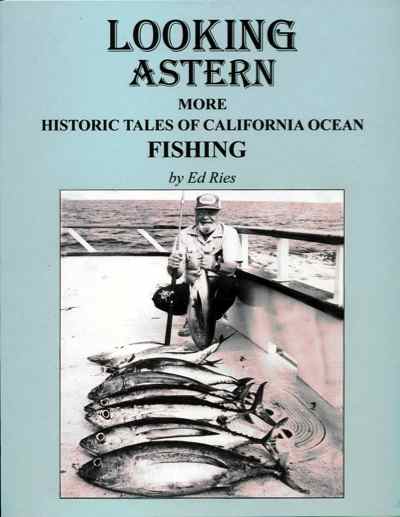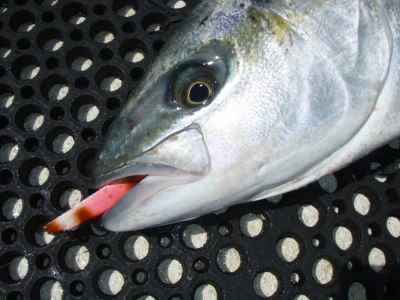Long Range Fish Report
From Sportfishing
From Sportfishing
Fish Report for 8-19-2011

The View Aft: Legacy Of A Fisherman
8-19-2011
Bill Roecker
Ed Ries' new book is his third in the series published by Monterey Publications in Laguna Hills. The first two were immensely successful, early sellouts. This one may be the best of them all, titled, "Looking Astern," and subtitled "More Historic Tales of California Ocean Fishing."
The book's cover is graced with a shot of Ed after a day of albacore fishing. He poses at the stern rail of the Cat Special on a trip with the staff of South Coast Sportfishing magazine, the one he continues to write for, now named Pacific Coast Sportfishing. Ed has a grin befitting his catch of fatso albies. Very few anglers can match his 80 years of fishing.
Inside, the new book offers 12 chapters spanning 149 pages crammed with lore, old photos and advertisements. Many nice shots of fishing boats, anglers and tackle give this coffee-table tome a special interest that all anglers will appreciate. I learned things I hadn't known before about cedar plugs, circle hooks, albacore and salmon fishing in the old days, as well as species seldom seen locally in modern times.
Having fished more than a few times with Ed on San Diego boats, I know how meticulous he is regarding tackle. His knowledge of the old ways of making and using tackle is a precious legacy. Writing about sand dab spreader rigs, Ed said, "Number six or eight hooks were hung on a variety of spreaders including barrel hoops, bicycle tire rims, wire coat hangers and handmade wire contraptions."
In his tackle and gear chapter, Ries pays homage to the original bone jigs, and presents photos and stories to tell about old lures like Baldys, Spoofers, Vivif rubber Toads, Dodgers and trolling jigs like Hetzels and Catalins. Ed also discusses the introduction of mono fishing line, which changed sportfishing forever.
Ed knows as much about commercial fishing as he does about sport fishing. He's done it all, been just about everywhere on the Pacific. He fished the South Seas, Central America and caught dogtooth tuna during during WW II. He wrote to me recently about the dogtooth, "...about 1944 at Eniwetok Atoll (later the site of the world's most powerful bomb blast)...I tossed out the bait (a small jack) and it was almost instant fish, as a dogtooth about 10 pounds gobbled it. When I wore him out, I didn't want to try to lift him up to the barge deck, so I eased him over the low rubber side of the life raft. There I admired him, marveling at his teeth when I carefully unhooked him. I had read of dogtooth tuna in Zane Grey's Tales of Tahitian Waters and I surmised that was what I caught. Later research proved I was right."
Ed Ries had a wealthy fishing career. He caught swordfish, tuna, blue marlin, sailfish, black sea bass, halibut and just about any game fish you can think of. He fished for mackerel and barracuda, white seabass, bonito and more different kinds of rockfish than you can shake a stick at. He knows about every sportfishing boat, barge or pier south of San Francisco, and in his day was a respected marine artist. You'll see some of his artwork in this book.
Fishing books are common here in southern California. A book like "Looking Astern" (also the name of the column Ed produces for Pacific Coast Sportfishing) is extremely uncommon. This is an excellent book, full of information you couldn't get any other way. After reading it through I've got to say it is truly special. Buy it. Every angler should have a copy in his or her fishing library.
The book's cover is graced with a shot of Ed after a day of albacore fishing. He poses at the stern rail of the Cat Special on a trip with the staff of South Coast Sportfishing magazine, the one he continues to write for, now named Pacific Coast Sportfishing. Ed has a grin befitting his catch of fatso albies. Very few anglers can match his 80 years of fishing.
Inside, the new book offers 12 chapters spanning 149 pages crammed with lore, old photos and advertisements. Many nice shots of fishing boats, anglers and tackle give this coffee-table tome a special interest that all anglers will appreciate. I learned things I hadn't known before about cedar plugs, circle hooks, albacore and salmon fishing in the old days, as well as species seldom seen locally in modern times.
Having fished more than a few times with Ed on San Diego boats, I know how meticulous he is regarding tackle. His knowledge of the old ways of making and using tackle is a precious legacy. Writing about sand dab spreader rigs, Ed said, "Number six or eight hooks were hung on a variety of spreaders including barrel hoops, bicycle tire rims, wire coat hangers and handmade wire contraptions."
In his tackle and gear chapter, Ries pays homage to the original bone jigs, and presents photos and stories to tell about old lures like Baldys, Spoofers, Vivif rubber Toads, Dodgers and trolling jigs like Hetzels and Catalins. Ed also discusses the introduction of mono fishing line, which changed sportfishing forever.
Ed knows as much about commercial fishing as he does about sport fishing. He's done it all, been just about everywhere on the Pacific. He fished the South Seas, Central America and caught dogtooth tuna during during WW II. He wrote to me recently about the dogtooth, "...about 1944 at Eniwetok Atoll (later the site of the world's most powerful bomb blast)...I tossed out the bait (a small jack) and it was almost instant fish, as a dogtooth about 10 pounds gobbled it. When I wore him out, I didn't want to try to lift him up to the barge deck, so I eased him over the low rubber side of the life raft. There I admired him, marveling at his teeth when I carefully unhooked him. I had read of dogtooth tuna in Zane Grey's Tales of Tahitian Waters and I surmised that was what I caught. Later research proved I was right."
Ed Ries had a wealthy fishing career. He caught swordfish, tuna, blue marlin, sailfish, black sea bass, halibut and just about any game fish you can think of. He fished for mackerel and barracuda, white seabass, bonito and more different kinds of rockfish than you can shake a stick at. He knows about every sportfishing boat, barge or pier south of San Francisco, and in his day was a respected marine artist. You'll see some of his artwork in this book.
Fishing books are common here in southern California. A book like "Looking Astern" (also the name of the column Ed produces for Pacific Coast Sportfishing) is extremely uncommon. This is an excellent book, full of information you couldn't get any other way. After reading it through I've got to say it is truly special. Buy it. Every angler should have a copy in his or her fishing library.
< Previous Report Next Report >
More Reports
Fishing Videos Reports
for Friday, August 19th, 2011
• After The Rocks
• At The Big Island
• Fujimoto Dream
• Shogun Report August 18, 2011
Fishing Videos Reports
for Thursday, August 18th, 2011
• West Coast Anglers
• Day At Guadalupe
• Qualifier 105 Report 8-16-2011
• Outstanding 'Tails
• First One Best

LongRangeSportfishing.net © 2025. All Rights Reserved.
Website Hosting and Design provided by TECK.net
Website Hosting and Design provided by TECK.net